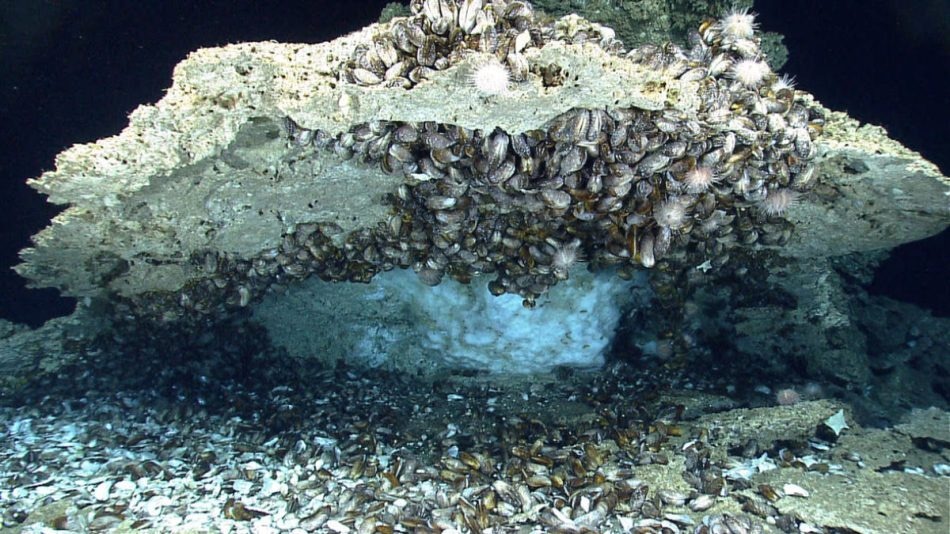Jun 28 2019
A new study performed by researchers from The University of Texas at Austin demonstrates that when carbon dioxide and air are injected into methane ice deposits buried underneath the Gulf of Mexico, enormous natural gas energy resources could be unlocked.
 Ice-like methane hydrates, shown here in the deep-sea Gulf of Mexico, hold vast amounts of energy. (Image credit: NOAA)
Ice-like methane hydrates, shown here in the deep-sea Gulf of Mexico, hold vast amounts of energy. (Image credit: NOAA)
This process could also help fight climate change by trapping the carbon dioxide beneath the ground.
The research has been reported in the Water Resources Research journal on June 27th, 2019. The process involves using computer models to simulate what happens when mixtures of air and carbon dioxide are injected into methane hydrate deposits. Methane hydrate is a water-rich, ice-like chemical compound that is naturally formed in low-temperature, high-pressure environments, for example, deep in the Gulf of Mexico and under Arctic permafrost.
According to Kris Darnell, study lead author and a recent doctoral graduate from the UT Jackson School of Geosciences, the study is the next step in finding solutions to two important global challenges: carbon storage and energy security.
Our study shows that you can store carbon dioxide in hydrates and produce energy at the same time.
Kris Darnell, Study Lead Author, Doctoral Graduate, UT Jackson School of Geosciences
Darnell’s research was funded by the University of Texas Institute for Geophysics (UTIG).
The researchers said that during this process, the methane is swept by the nitrogen in the injected air toward a production well and enables carbon dioxide to assume its place. The excellence of this method lies in the fact that natural gas is extracted from methane hydrate deposits and simultaneously, carbon dioxide (a greenhouse gas) is stored in a deep environment where it is unlikely to be liberated into the atmosphere where it could add to climate change.
This is not the first time that hydrate deposits have been proposed for the storage of carbon dioxide. Previous efforts were either failure or generated lackluster outcomes. The new research resolves the physics that underlies the process to unravel why earlier efforts failed and how to rectify this.
According to Darnell, the next step is to verify their findings in a laboratory. At present, the Jackson School and the UT Hildebrand Department of Petroleum and Geosystems Engineering are testing the process in a specialized facility in the Jackson School, one of the very few in the world with the potential to store and test methane hydrate.
The study has been led by Peter Flemings, a Jackson School professor and senior UTIG research scientist, and David DiCarlo, a professor in the Hildebrand Department. Both are co-authors of the paper.
Two things are really cool. First, we can produce natural gas to generate energy and sequester CO2. Second, by swapping the methane hydrate with CO2 hydrate, we disturb the (geologic) formation less, lowering the environmental impact, and we make the process energetically more efficient.
Peter Flemings, Professor, UT Jackson School of Geosciences
If it can be demonstrated that the process works in the field on an industrial scale, it has vast potential.
Methane hydrate is one of a class of chemical compounds called gas hydrates in which gas molecules get trapped within cages of water ice molecules instead of chemically bonding with them.
UT and the U.S. Department of Energy (DOE) are collaborating to analyze naturally forming methane hydrates with the goal of finding out their potential as an energy resource. This is crucial since estimates propose that methane extracted from hydrate deposits that occur underneath the Gulf of Mexico alone could power the country for several hundred years.
In the study, the researchers demonstrated that a process where one molecule type trapped in hydrate is exchanged for another (known as guest molecule exchange) is a two-stage process and not a single, simultaneous process, as it was considered earlier.
Firstly, nitrogen disintegrates the methane hydrate. Secondly, the carbon dioxide becomes crystallized into a slow-moving carbon dioxide hydrate wave behind the escaping methane gas.
The computer simulations suggest that it is possible to repeat the process with increasing concentrations of carbon dioxide to a point where the reservoir gets saturated. According to the researchers, in contrast to some carbon storage methods, this offers a ready incentive for industry to start the storage of carbon dioxide, a major climate change driver.
“We’re now openly inviting the entire scientific community to go out and use what we’re learning to move the ball forward,” stated Flemings.
DOE supported the study that culminated in the paper.